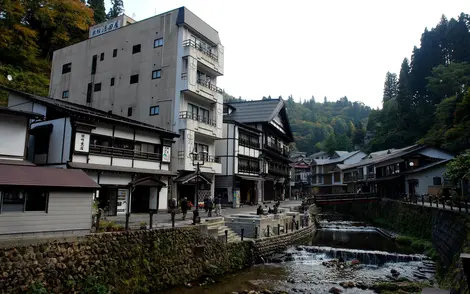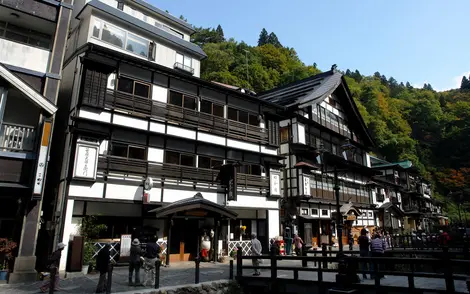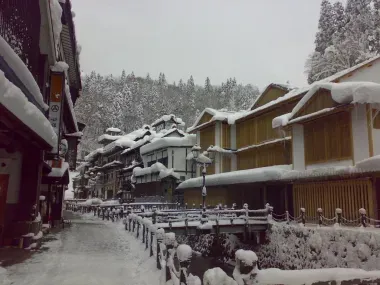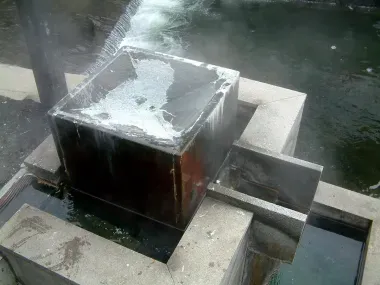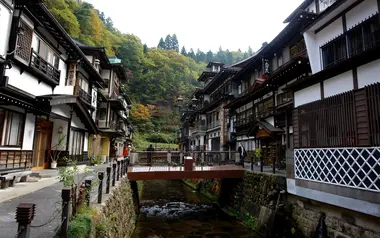Ginzan Onsen
- Published on : 19/02/2018
- by : S.R.
- Youtube
The silver onsen
Onsen , or hot springs, are an institution in Japan. These hot baths, whose water comes from volcanic springs, have for centuries been reputed to have a certain therapeutic value. They are found throughout the country, and every Japanese has already set foot. Let's focus today on Ginzan Onsen , a Tohoku village famous for its thermal baths.
A village in one street
Ginzan Onsen is basically a village in Yamagata Prefecture, located in a mountainous region, which was born following the discovery of a silver mine as its name suggests ( ginzan meaning "silver mine" in Japanese ). It then developed around the local hot springs. The city consists of a single street, on both sides of which there are ryokan , or traditional Japanese inns, with three or four floors. Traditional restaurants and souvenir shops complete the picture of an entirely pedestrian street - the cars do not have access to the narrow lanes - all covered with ancestral buildings resembling ancient Japan , a poetry that is completely revealed in winter, when the snow comes whitewash old roofs.
Read : The ryokan
Desonsen, more onsen
There are no outdoor onsen within Ginzan Onsen village. Each hotel has thermal baths, open to visitors who can access these springs without having to pay for an overnight stay (for a price of between 300 and 1,500 yen/about €2 to €12). Two public baths, with an entrance cost of 300 to 500yen (between 2 and 4€), are open in the center of the city, as well as a foot bath (free). In addition, there is another public bath, but this time for private use, Omokageyu, which opens its doors to visitors for 2,000 yen (14€) for 50 minutes.
Read also : Free onsen
New procedures for day visitors
Ginzan Onsen is implementing new rules to preserve the tranquility and unique experience of visitors. From now on, day visitors must reserve their access to the onsen in advance in order to regulate the number of people. This new measure aims to limit the influx and ensure a more peaceful stay for everyone. Time slots must be reserved online or at participating hotels, and daily quotas have been established. Visitors who have not reserved may be refused entry to the baths.
- For arrivals by public bus after 4 p.m., a ticket is also required. A new direct bus service from Ōishida Station will be available from November, making access easier for tourists.
Learn more : Guide to winter tourism in Ginzan Onsen
Coming out of the water, the mine opens
Ginzan Onsen has other pleasures to offer. After a good bath, the walker can follow the course of the Ginzan River, which crosses the city, before stopping at Shirogane Park. The Shirogane-no-taki waterfall, whose waterfall falls over 22 meters at the back of the city, is not to be missed ! After passing the waterfall, and after a short quarter of an hour walk through the forest, you will find the nobezawa-ginkodo (lava of the silver mine) . It opens onto an entrance fitted out with wooden logs. The interior of the mine is illuminated, and can be visited, with 30-minute tours . There, you will discover excavations over 500 years old, carried out when Japan was still under the power of the Tokugawa shoguns . Note that the path leading to the mine is not passable during winter and early spring due to snowfall.
So, do you want onsen in the mountains?
See : Iwami Ginzan
Address, timetable & access
Address
Timetable
Access by train from Tokyo to Oidashi station via the JR Yamagata Shinkansen, for 12,000 yen. From Oidashi, a bus departs every 60-90 minutes, takes 35 minutes to reach Ginzan Onsen and costs 710 yen.






